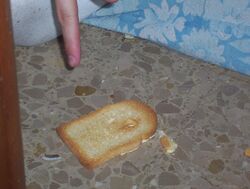Physics:Buttered toast phenomenon
The buttered toast phenomenon is an observation that buttered toast tends to land butter-side down after it falls. It is used as an idiom representing pessimistic outlooks.[1] Various people have attempted to determine whether there is an actual tendency for bread to fall in this fashion, with varying results.
Origins
The phenomenon is said[by whom?] to be an old proverb from "the north country". Written accounts can be traced to the mid-19th century. The phenomenon is often attributed to a parodic poem of James Payn from 1884:[2][3]
I never had a slice of bread,
Particularly large and wide,
That did not fall upon the floor,
And always on the buttered side!
In the past, this has often been considered just a pessimistic belief. A 1991 study by the BBC's television series Q.E.D. found that when toast is tossed into the air, it lands butter-side down just one-half of the time (as would be predicted by chance).[4] However, several scientific studies have found that when toast is dropped from a table (as opposed to being thrown in the air), it more often falls butter-side down.[5][6][7] A study on this subject by Robert Matthews won the Ig Nobel Prize for physics in 1996.[8][9]
Explanation
When toast falls out of one's hand, it does so at an angle causing the toast to rotate. Given that tables are usually between two and six feet (0.7 to 1.83 meters), there is enough time for the toast to rotate about one-half of a turn, and thus lands upside down relative to its original position. Since the original position is usually butter-side up, the toast lands butter-side down.[10] However, if the table is over 10 feet (3.0 meters) tall, the toast will rotate a full 360 degrees, and land butter-side up.[11] Also, if the toast travels horizontally at over 3.6 miles per hour (1.6 m/s), the toast will not rotate enough to land butter-side down.[4] In fact, the phenomenon is caused by fundamental physical constants.[8]
Other factors
The added weight of the butter has an effect on the falling process,[12] since the butter spreads throughout the slice.[4] A piece of toast has inertia as it flips towards the floor, preventing its spin from stopping easily; it is usually only stopped by hitting the floor. This moment of inertia is determined by the speed at which the toast is flipping, combined with the size and mass of the toast. Because most toast is relatively uniform, they often land in a similar manner.[13]
See also
- Buttered cat paradox
- Murphy's law
- The Butter Battle Book
- Finagle's law § Variants
- Resistentialism § Similar concepts
References
- ↑ Martin, Gary. "'Why does bread always fall buttered side down?' - the meaning and origin of this phrase" (in en). http://www.phrases.org.uk/meanings/butter-side-down.html.
- ↑ Apperson, George Latimer (2005). Dictionary of Proverbs. Ware: Wordsworth Editions Ltd.. pp. 69–70. ISBN 978-1840223118. https://books.google.com/books?id=7PMZJqSR4sAC&q=buttered. Retrieved 2015-04-13.
- ↑ Manser, Martin H. (2007) (in en). The Facts on File Dictionary of Proverbs. Infobase Publishing. ISBN 9780816066735. https://books.google.com/books?id=fgaUQc8NbTYC&dq=%C2%A0James+Payn+from+1884+butter+side+down&pg=PA32.
- ↑ 4.0 4.1 4.2 Stewart, Ian (1995). "The Anthropomurphic Principle". Society for Industrial and Applied Mathematics. http://www.whydomath.org/Reading_Room_Material/ian_stewart/anthro/anthro.html. Retrieved 21 December 2012.
- ↑ Matthews, Robert (27 May 2001). "Breakfast at Murphy's (or why the toast lands butter-side down)". The Telegraph. https://www.telegraph.co.uk/news/uknews/1331810/Breakfast-at-Murphys-or-why-the-toast-lands-butter-side-down.html. Retrieved 19 December 2012.
- ↑ Matthews, R. A. J. (1995). "Tumbling toast, Murphy's Law and the fundamental constants" (in en). European Journal of Physics 16 (4): 172–176. doi:10.1088/0143-0807/16/4/005. ISSN 0143-0807. Bibcode: 1995EJPh...16..172M.
- ↑ Bacon (2001). "A closer look at tumbling toast". American Journal of Physics 69 (1): 38–43. doi:10.1119/1.1289213. Bibcode: 2001AmJPh..69...38B. https://space.umd.edu/dch/p405s04/AJP00038.pdf. Retrieved 21 November 2017.
- ↑ 8.0 8.1 Matthews, R A J (18 July 1995). "Tumbling toast, Murphy's Law and the fundamental constants". European Journal of Physics 16 (4): 172–176. doi:10.1088/0143-0807/16/4/005. Bibcode: 1995EJPh...16..172M.
- ↑ Inglis-Arkell, Esther (13 December 2011). "An Experiment That Solves The World's Most Important Question: How to Keep Toast from Landing Buttered-Side Down". io9. http://io9.com/5867322/an-experiment-that-solves-the-worlds-most-important-question-how-to-keep-toast-from-landing-buttered+side-down. Retrieved 19 December 2012.
- ↑ Devlin, Keith (July 1998). "Buttered Toast and Other Patterns". https://www.maa.org/external_archive/devlin/devlin_july_98.html. Retrieved 19 December 2012.
- ↑ Valsler, Ben (16 December 2007). "Butter Side Down". The Naked Scientists. BBC. Retrieved 21 December 2012.
- ↑ Wollard, Kathy (2009-08-17). "Why does a falling piece of toast always seem to land on the buttered side?". How Come?. http://www.how-come.net/2009/08/17/why-does-a-falling-piece-of-toast-always-seem-to-land-on-the-buttered-side/. Retrieved 21 December 2012.
- ↑ "Mythbusters Museum" (in en). http://www.mythbusterstheexhibition.com/science-content/butter-side-up/#article.
 |


